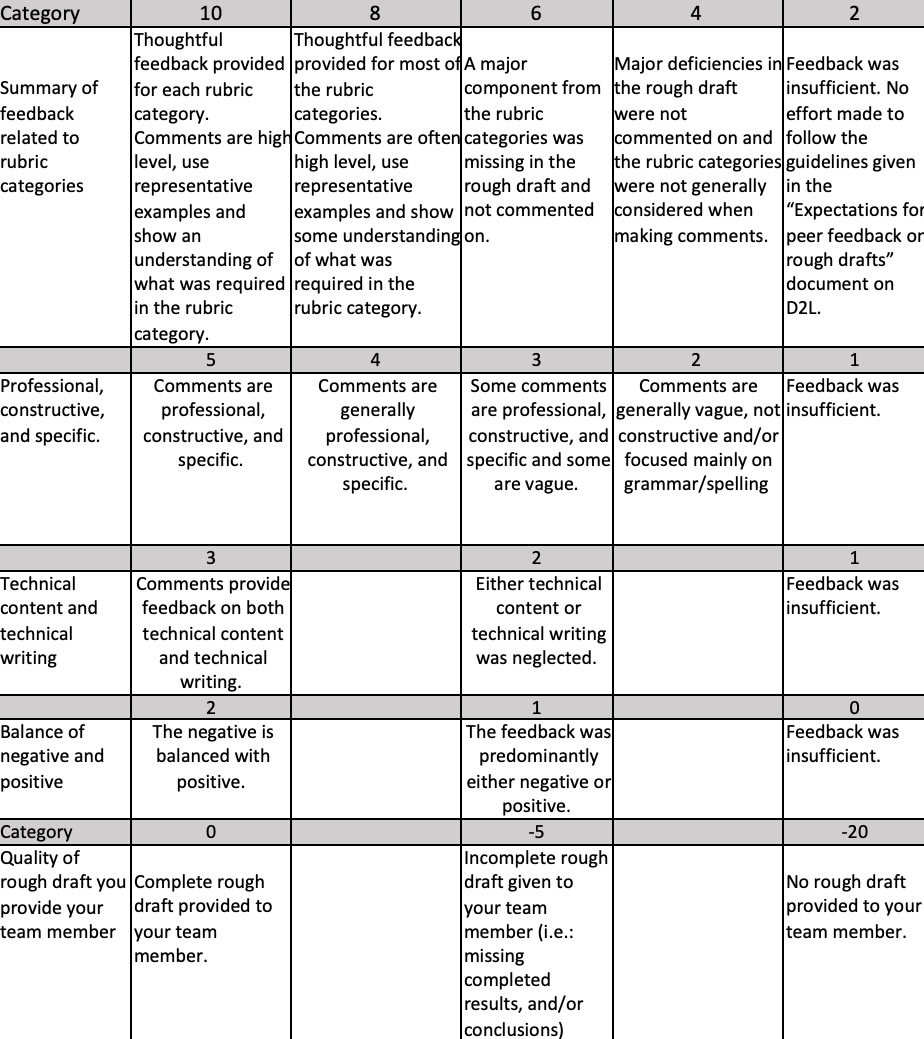Incorporating Feedback and Revision into a Technical Writing Assignment in a STEM Laboratory Course
What this resource is about:
This resource is about incorporating feedback and revision into a technical writing assignment in a STEM laboratory course.
What is feedback and revision?
Feedback and revision are closely related. Feedback can be comments from instructors, peers, or other reviewers. Revision can involve anything from correcting errors and clarifying ideas to reorganizing entire sections or adding new content. The goal of feedback and revision is to refine and improve the work to better meet its intended purpose or audience.
Reflection from Dr. Brown:
A technical writing course is not required in the chemical engineering curriculum at MSU, and communication training primarily occurs in our senior laboratory courses and capstone design courses. After receiving an “Integrating Writing into STEM” grant from the Writing Center, I learned more about what makes writing assignments meaningful and how to do effective assessment. Two main themes became apparent: 1) revision is a key component of the writing process, and 2) instructors and students need to know how to give and receive feedback. While most students revise in some fashion and many seek feedback on their own, integrating them into the course provided a built-in opportunity for students to revise their writing and gave them a chance to practice communicating with peers about their writing in a professional way.
I had the students swap reports and provide feedback to a classmate in the form of a professional email (in addition to any comments given in the body of the report). They cc’d the instructor on the email and were graded on the quality of their feedback. Students then revised their reports before handing in the final version to their instructor.
Benefits:
With peer feedback, the students’ communication skills are improved because they see more examples of writing and have to organize thoughts around why writing was effective or not in order to articulate their feedback. Knowing how to give feedback is critical for working in or managing teams and would be a useful skill for any practicing engineer. Students were instructed to structure their feedback around the technical report rubric categories. This required them to become familiar with the technical report rubric and think more deeply about the rubric categories.
Challenges:
It takes time to teach students about feedback and how to give effective feedback. I gave a short lecture explaining the benefits of both giving and receiving feedback, what makes feedback effective, and the necessity of incorporating the feedback into revision and future work. I also set aside lab time for students to go to the Writing Center to work with tutors on their feedback assignments. I provided written guidelines to students, and I used the same guidelines for myself during the grading process.
Guidelines for Giving Effective Feedback:
Effective feedback will be professional, constructive, specific, and high-level.
- Practical advice should be given in a respectful manner, rather than pointing to faults or attacking.
- The feedback should be a balance of what was done well and what are opportunities for improvement.
- Rather than vague comments such as “This is good!”, make comments specific such as “Good job making sure all information included is connected to the objective!” or “The order of these paragraphs doesn’t make sense because.... “.
- Comments should be “high-level”, focusing on issues such as organization or how well the writing meets the needs of the audience, context, and purpose rather than spelling and grammar. Types of comments can fall into several categories, such as believing and praising (“This report works well because...”), helping and questioning (“What are your reasons for drawing ‘X’ conclusion?” or doubting and challenging (“This information is not relevant to the objective”).
- People can take in only so much constructive feedback, so don’t edit the entire document. Rather, point to representative examples to demonstrate errors and things done well.
Assignment Summary:
The assignment was a technical report that summarized the results of an experiment. Students exchanged the rough draft of their report with another student and went to the Writing Center during one of their lab times to write feedback on the rough draft during that time.
Students were instructed to:
- Read the rough draft of the report.
- Make comments and edits directly on the rough draft (using tracked changes in word, comments on a pdf, written comments on a printed copy or another method).
- Summarize their comments in an email, making sure to address each category in the rubric and address what could be improved as well as what was done well.
Instructors graded the quality of the feedback and the quality of the professional email. Students also uploaded a copy of the rough draft, including any comments/edits made in it, to a designated D2L assignment folder so that scores could be entered there and linked to a grade item.
Grading Rubric for Peer Feedback Email:
Here is the grading rubric I used to evaluate the peer feedback email.

